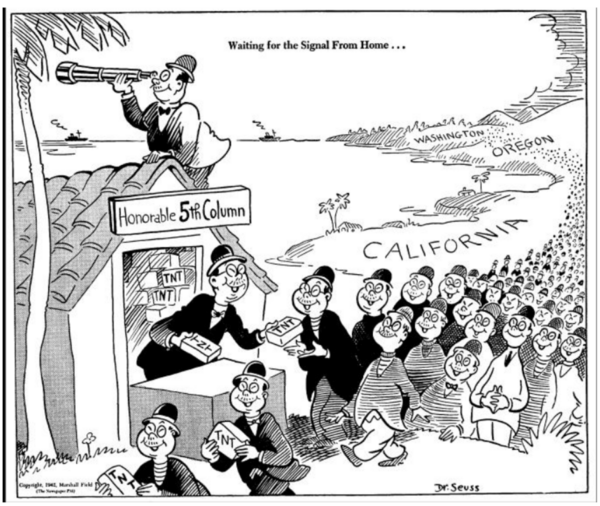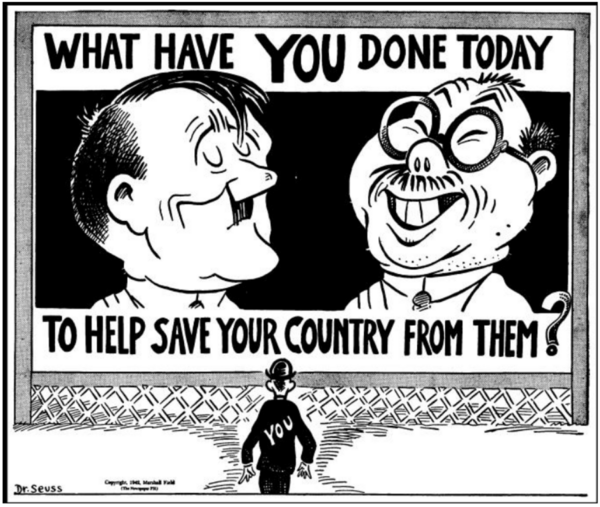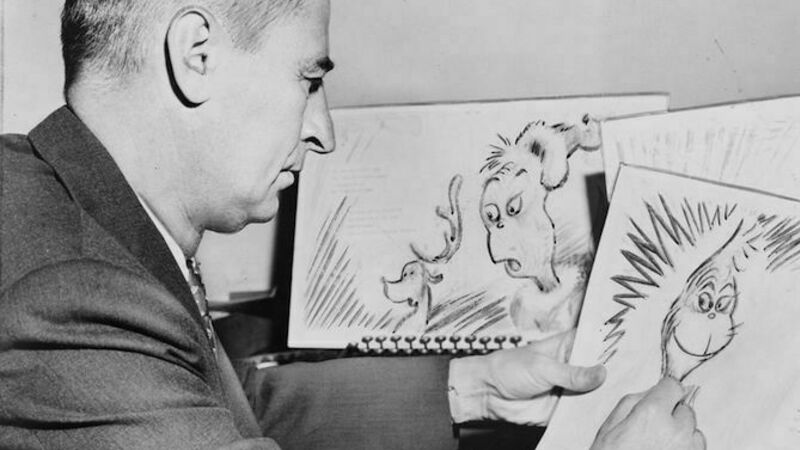There was racism and stereotypes
From here to the moon!
And to think that I saw it
In Dr. Seuss' cartoon…
Dr. Seuss is the most misunderstood staple of early education in America. The Cat in the Hat, Green Eggs and Ham, How the Grinch Stole Christmas, and numerous other 'Seussian' titles are now classic children's books featured in seemingly every elementary school library across the nation. The books have been adapted into movies and plays, and "Dr. Seuss Week" is celebrated in schools. But what is this really promoting? Multiple generations attribute their ability to read and rhyme to the work of Dr. Seuss, but very few people have heard of his more controversial work. Most do not even know the real name of Dr. Seuss, much less that his career bore the stains of racial stereotyping. Theodor Geisel was the man behind the pseudonym, and he employed his art and wit as a political cartoonist to abolish Jim Crow Laws and refute anti-Semitism. Yet, with the same pen, he encouraged racism against the Japanese and Japanese-Americans. There is undoubtedly an unacceptable and unspoken racial hypocrisy in the early work of Ted Geisel. This begs the question, can we forgive Dr. Seuss?
The name "Dr. Seuss" began to gain fame when Geisel received his first salaried job drawing advertisements for Flit bug-spray (Minear 9). Once he had established this steady source of income, he started his career as a children's author with And to Think that I Saw It on Mulberry Street! (9-10), a tale of a boy imagining the exciting scenarios to tell his father he saw on the way home from school. However, these harmless themes changed dramatically at the dawn of World War II. Geisel said, "I had no great causes or interest in social issues until Hitler" ("The Political Dr. Seuss"), but once he had developed this passion for political activism, it would carry into his work for the rest of his life. His first method of activism was through incredibly blunt political cartoons in the liberal periodical PM. According to Ralph Ingersoll, the editor of the magazine, PM's official stance was that they were "against people who push other people around, just for the fun of pushing, whether they flourish in this country or abroad" (Minear 13). Due to this outlook, the magazine proudly published Dr. Seuss' editorial cartoons that denounced isolationists, Hitler, racism against African-Americans, and anti-Semitism. Sadly, despite all of these progressive foundations, it also published backwards pictures such as Seuss' "Waiting for the Signal From Home" cartoon (see Figure 1).

This highly racially-charged cartoon portrays Japanese-Americans as stereotypically squinty-eyed, buck-toothed traitors, malevolently grinning as they gather TNT and "wait for the signal from home" ("'Said-A-Bird'" par. 22), rather than as loyal American citizens. In fact, most Japanese-American immigrants had left Japan to escape the militaristic regime of their ancestors and considered themselves Americans first and only (Smith 1, 4). Interestingly, many Japanese-Americans were American-born citizens as distant from their Japanese heritage as Geisel from his own German roots (Minear 9). However, Dr. Seuss shamelessly took advantage of the obvious physical differences between the Japanese and the European Axis powers. While he showed sympathy for the German people in his cartoons and reserved the ridicule for Germany's leaders, the Japanese were always demonstrated by a generic, stereotypical Japanese caricature ("'Said a Bird'" par. 22). The "What Have You Done Today…?" cartoon (see Figure 2) is a compelling example of the tendency to vilify Hitler while vilifying the entirety of the Japanese people that was, unfortunately, very characteristic of our beloved Dr. Seuss.

With these cartoons, Seuss postulated that anyone who looked Japanese or came from a Japanese background was anti-American and not to be trusted. He did not portray their leader or corrupted government as the threat, but each and every Japanese individual, a perspective that resulted in grave consequences. Editorial cartoons and other extreme exaggeration by the media, known as 'Yellow Journalism,' increased anti-Japanese paranoia on the Western Coast. The mass hysteria that resulted led to discrimination, violence, raids, and, ultimately, the Japanese-American internment camps, in which 112,000 people were detained from 1942-1945 (Smith 3). The majority of Americans were already enraged at anyone of Japanese origin because of the attack on Pearl Harbor, and Dr. Seuss' cartoons in PM did nothing but contribute to the atmosphere of fear and suspicion.
In addition to his free-lance work, Dr. Seuss created anti-Japanese propaganda for the U.S. Army. After having been repeatedly accused of driving America into a war he would no way fight ("Children's Literature" 468), Geisel enlisted in the Army in 1943, earning the title of Commander Captain Theodor Geisel of the Animation Department (Schlumbohm par. 8). He served in the First Motion Picture unit, where he was charged with producing short,"informational" films, primarily those featuring "Private SNAFU" (par. 8). Private SNAFU clips were shown to educate the military, and they were also displayed to the public before each movie in every single movie theatre across the nation (Rosato). This meant that the propaganda perpetuated in the films had a national audience and racism was given entertainment value. The short film "Spies" features depictions of Germans, Italians, and Japanese people, but there is an intentionally alienating distinction between the portrayal of the Europeans and the Japanese ("Children's Literature" 478-479). Moreover, in "The Aleutians-Isle of Enchantment (Oh, Brother!)," a Japanese man is shown hopping from island to island to sneak in through the "back door" of America (479). However, when the runty "Jap,"as the narrator refers to him, attempts to open the door, he is faced with a brawny American soldier three times his height, who stomps on his foot, causing the terrified "Jap" to scamper back into the ocean, yelling, "Ooh! Reglettable incident!" (479). This example illustrates the breadth of stereotypes the cartoons would exploit, including physical and lingual, and the use of the derogatory term "Jap." By taking part in the creation of the "Private SNAFU" films containing these messages, Dr. Seuss aided the First Motion Picture Unit in spreading anti-Japanese propaganda to soldiers and citizens alike.
Philip Nel, author of Children's Literature Goes to War, makes the important point that the use of propagandistic stereotyping in war is not surprising or uncommon; however, the hypocrisy of an otherwise actively anti-discriminatory cartoonist is surprising as well as unacceptable (479). While it may not be right, it is a normal practice for a nation to capitalize on their monopoly on information distribution to dehumanize the enemy (Rosato); but that Dr. Seuss would allow himself to become a tool for these means on such a shallow, racial level is disappointing, to say the least.
This disappointment brings us to the question: can we forgive our childhood hero? Some argue that Dr. Seuss still outfitted the villains of his later children's books with "Asiatic features" (Rosato), thus proving that he did not truly change, and, therefore, doesn't merit forgiveness. However, this idea can be dismissed with the amendments he made to his work. Seuss actually revised his first children's book, And To Think That I Saw it on Mulberry Street, to create a less stereotypical version of another Asian man. Geisel addressed this issue, saying, "I had a gentleman with a pigtail. I colored him yellow and called him a Chinaman. That's the way things were fifty years ago. In later editions I refer to him as a Chinese man. I have taken the color out of the gentleman and removed the pigtail." ("'Said a Bird'" par. 25). This revision shows his commitment to owning up to and amending his past racist ideologies.
Others justify his work by purporting that he was not "as bad" as other cartoonists, because he only portrayed the Japanese as monkeys once, even though it was very common at the time to depict Japanese people as primates (Dr. Seuss 57). For example, the editorial cartoonist David Low published a piece for London's Evening Standard in 1941 that depicted an Asiatic monkey with the word "Jap" on its rear and a knife in its hand. Juxtaposed with Low, Seuss rarely sinks to the low of using animals to symbolize and thus dehumanize the Japanese (57). These arguments propose that historical context, while it does not pardon his cartoons, makes them comparably less pernicious (Minear 118). The outlook of the society around Geisel may add clarification for his thought process, but it is not the only reason he deserves forgiveness. No, the reason we should forgive Dr. Seuss is for the transformation he had regarding the Japanese later in the war and for the years to follow it.
Geisel's change of heart first manifested in films he made during and shortly after World War II. The first of these was Your Job in Japan. This instructional video for the military was written by Seuss in 1945; however, Seuss' version was quashed by General MacArthur because it was apparently "too sympathetic" (Dr. Seuss 57). Two years later, Design for Death was put together by Seuss and his wife, Helen, and "'portrayed the Japanese people as victims of seven centuries of class dictatorship'" ("'Said-A-Bird'" par. 24). It tells its audience that the Japanese were not inherently evil, just misinformed, and stresses the importance of helping countries that are at the mercy of authoritarian governments (Minear 262). This view directly contrasts that of the "What Have You Done Today…" cartoon (see figure 2). Instead of vilifying the entirety of the Japanese people, Seuss now used Design for Death to send a very powerful message to America about the distinction between hostile governments and their suppressed civilians. The film even won the 1947 Academy Award for the best feature-length documentary (262). However, these movies were just the beginning of Dr. Seuss' attempt to convey his own conversion to the American public.
The pinnacle of his transformation was through his 1954 book, Horton Hears A Who!. This story was written after Dr. Seuss' visit to Japan and is dedicated to a professor he met during his travels, his "Great Friend, Mitsugi Nakamura of Kyoto, Japan" ("'Said-A-Bird'" par. 21; Seuss). It is the tale of Horton the elephant, whose keen hearing makes him aware of a civilization—Who-ville—existing on a tiny speck. When he tries to tell the other creatures in the jungle about his discovery, they all call him crazy and try to sabotage the speck. This results in Horton having to overcome many obstacles in an attempt to protect his new friends from utter destruction. After nearly being annihilated by the other animals' antics, the whole town of Who-ville gathers together to make enough noise to be heard by all the animals of the jungle, but it is not until little Jo-Jo, a Who who is silently playing with his yo-yo, contributes his small little yell that the Whos are finally heard. Once the jungle animals realize that Horton was indeed telling the truth, they vow to protect the Whos as well.
Richard Minear, author of Dr. Seuss Goes to War, suggests that Horton Hears a Who! is actually about the American war tactics in Japan and the bombing of Hiroshima and Nagasaki (264). He claims that it is a representation of how Seuss wishes the United States would have handled the situation in Japan (264). Philip Nel also states that Horton Hears a Who! is an "allegory advocating equal treatment of all people" (Dr. Seuss 54). It is Dr. Seuss' attempt to rewrite history for what the United States, symbolized by Horton, should have done for the Japanese, represented by the Whos (54). Ruth K. MacDonald also believes that the Whos can be correlated to the Japanese Seuss met on his visit to Japan in 1953, saying that they are "a people whom he found optimistic, hardworking, and particularly eager to vote in their elections" (Minear 264). This is yet another motive Seuss would have for writing Horton Hears a Who!: to encourage readers that, as Henry Jenkins says, "even the 'small' have an obligation to contribute to the general welfare" (Dr. Seuss 57).
In addition to the view of the national allegory, I argue that Dr. Seuss also meant Horton Hears a Who! as his own apologia for his role in the racism. He undoubtedly wished, much like the United States, that he had played the role of Horton in gallantly defending the minority, but his role in his attempt to rewrite the past would be that of Jo-Jo. The Mayor of Who-ville, who has rounded glasses very similar to those of Franklin Delano Roosevelt, puts Jo-Jo on top on the Eiffelberg Tower, just as the President kept Geisel in the public eye by his close connections to PM (Schiffrin 9). Since Roosevelt only sent the Japanese-American to internment camps due to excessive pressure from the public (Smith 5), Geisel may have suspected in hindsight that FDR had hoped he would have used his editorial talents to calm the hysteria, rather than promote it. In having Jo-Jo's "Yopp!" be the addition that allowed the Whos to be heard, Dr. Seuss is stressing the power of a single voice making all the difference for a people (Boyd 203), and, with it, showing how he should have used his voice to protect the Japanese, rather than denigrate them. He more explicitly apologizes when he puts himself in his rightful place in history with the previously skeptical kangaroo, who says "from now on, you know what I'm planning to do?... From now on, I'm going to protect them with you" (Seuss 58). The transformation of this kangaroo, who had been the main instigator in convincing the other animals that actual persons could not live on the speck, shows the transformation of Geisel's personal beliefs. He then shows his larger objective for the book when the when the young kangaroo says, "Me too! From sun in the summer. From rain when it's fall-ish, I'm going to protect them. No matter how small-ish!"
Dr. Seuss used his children's literature to begin his legacy as a teacher of tolerance, acceptance, and imagination. These lessons, ironically, are a result of his questionable past as a cartoonist. His work as a political cartoonist for PM had contradictory messages about racism, because, even though he expressly opposed it in some cases, he encouraged prejudice against the Japanese. He even used the beginning of his service to the military as an opportunity to sell this propaganda to the public. These actions were travesties that, in most cases, would be unforgivable. However, Dr. Seuss, as we have learned throughout the years, defies the norm. His views towards the Japanese took a complete turn towards the end of the war, and he focused his energy towards to enlightening the public to his new way of thinking. Through his educational films and allegorical apology of Horton Hears a Who!, he became the Dr. Seuss generations have come to love. When we celebrate Dr. Seuss, we don't just celebrate a cat sporting a hat, dubious eggs and ham, or a grouch who hated Christmas. When we celebrate Dr. Seuss, we celebrate Theodor Geisel, a man who had flaws, but who also had the understanding and courage to change his views to better himself, and perhaps even better the world.
Because of his change of heart
And Horton Hears a Who!
I can forgive Dr. Seuss…
Can you?
Works Cited
Boyd, Brian. "The Origin of Stories: Horton Hears a Who." Philosophy and Literature 25.2(2001): 197-214. Print.
Minear, Richard H., and Theodor Seuss Geisel. Dr. Seuss Goes to War: The World War II Editorial Cartoons of Theodor Seuss Geisel. New York: New, 1999. Print.
Nel, Philip. Dr. Seuss: American Icon. New York: Continuum, 2004. Print.
___. "'Said-a-Bird-in-the-Midst-of-a-Blitz...': How World War II Created Dr. Seuss." Mosaic-a Journal for the Interdisciplinary Study of Literature 34.2 (2001): 65-85. Print.
___. "Children's Literature Goes to War." Journal of Popular Culture 40.3 (2007): 468-87. Print.
Rosato, Sebastian. Personal Interview. 10 Nov. 2014.
Schiffrin, André, and Theodor Seuss Geisel. Dr. Seuss & Co. Go to War: The World War II Editorial Cartoons of America's Leading Comic Artists. New York: New, 2009. Print.
Schlumbohm, Brian. "Dr. Seuss, The Cat in the Army Hat," States News Service. 10 Mar 2011. Expanded Academic ASAP. Web. 17 Nov. 2014.
Seuss. Horton Hears a Who!. New York: Random House, 1954. Print.
Smith, Kelly. "The Infamy of Internment." 2013. Print.
"The Political Dr. Seuss." Independent Lens. PBS, 2014. Web. 12 Nov. 2014.

